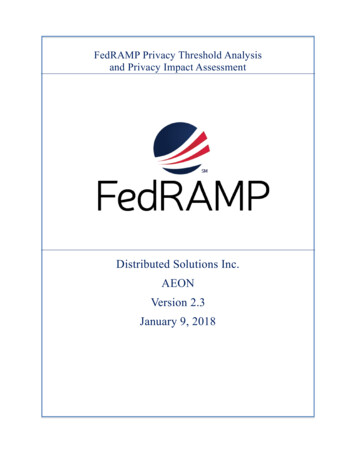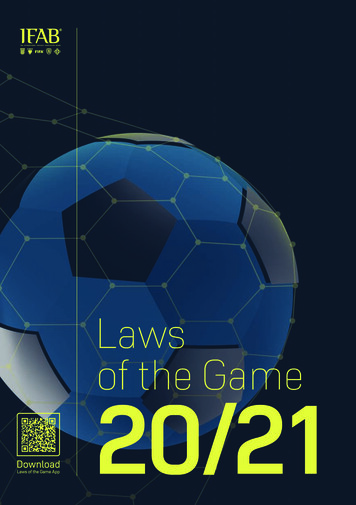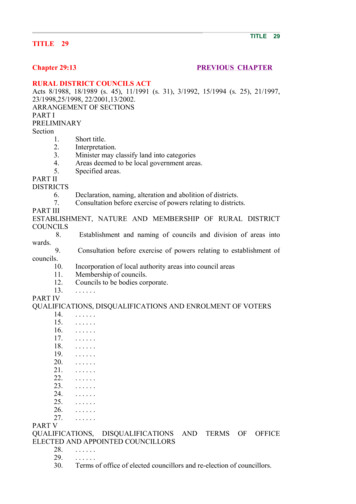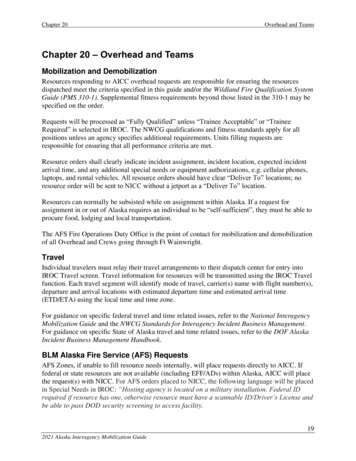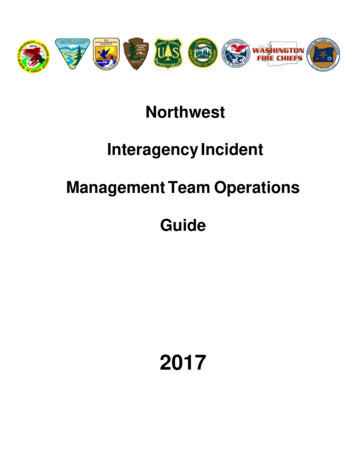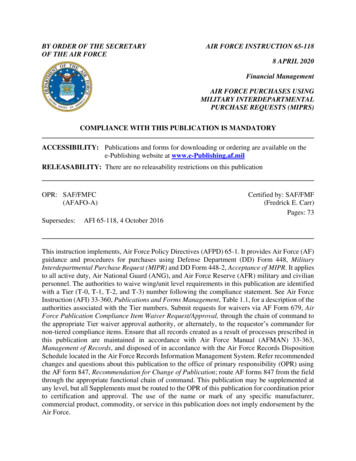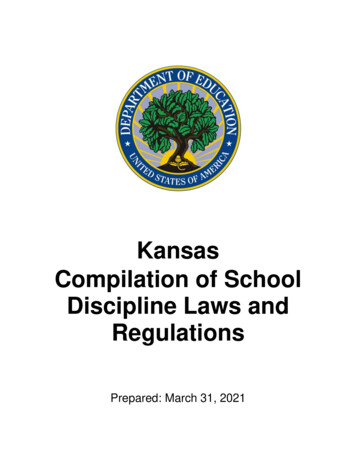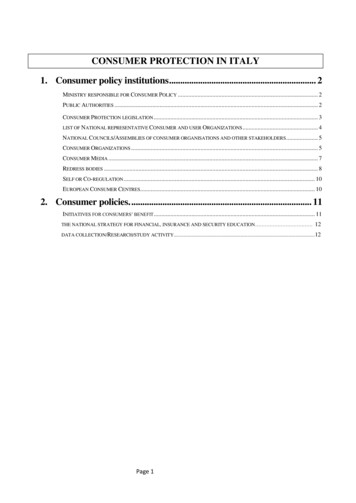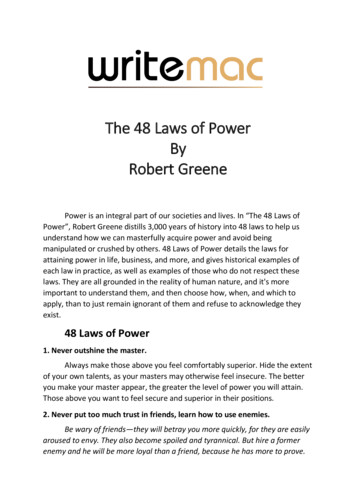
Transcription
Interagency ConsumerLaws and RegulationsEFTAElectronic Fund Transfer ActThe Electronic Fund Transfer Act (EFTA) (15 U.S.C. 1693 et seq.) of 1978 is intended to protectindividual consumers engaging in electronic fund transfers (EFTs) and remittance transfers.These services include: Transfers through automated teller machines (ATMs);Point-of-sale (POS) terminals;Automated clearinghouse (ACH) systems;Telephone bill-payment plans in which periodic or recurring transfers are contemplated;Remote banking programs; andRemittance transfers.The EFTA is implemented through Regulation E, which includes official interpretations.In 2009, the Board of Governors of the Federal Reserve System (Board) amended Regulation Eto prohibit institutions from charging overdraft fees for ATM and one-time debit cardtransactions, unless the consumer opts in or affirmatively consents to the institution’s overdraftservices (74 Fed. Reg. 59033 (Nov. 17, 2009) and 75 Fed. Reg. 31665 (June 4, 2010)). TheBoard also amended Regulation E to implement provisions in the Credit Card AccountabilityResponsibility and Disclosure Act of 2009 that restricted fees and expiration dates on gift cards,and to require that gift card terms be stated clearly (75 Fed. Reg. 16580 (April 1, 2010)). 1The Dodd-Frank Wall Street Reform and Consumer Protection Act of 2010 (Dodd-Frank Act)generally transferred rule-making authority under the EFTA from the Board to the ConsumerFinancial Protection Bureau (CFPB or Bureau). 2 3 The Dodd-Frank Act also amended the EFTAand created a new system of consumer protections for remittance transfers sent by consumers inthe United States to individuals and businesses in foreign countries. In December 2011, theCFPB restated the Board’s implementing Regulation E at 12 CFR Part 1005 (76 Fed. Reg.81020) (Dec. 27, 2011). In February 2012, the CFPB added Subpart B (Requirements forRemittance Transfers) to Regulation E to implement the new remittance protections set forth in1T he Board also implemented a legislative extension of time for complying with the gift card disclosure requirements untilJanuary 31, 2011. 75 Fed. Reg. 50683 (August 17, 2010).2Dodd-Frank Act §§ 1002(12)(C), 1024(b)-(c), and 1025(b)-(c); 12 U.S.C. 5481(12)(C), 5514(b)-(c), and 5515(b)-(c). Section1029 of the Dodd-Frank Act generally excludes from this transfer of authority, subject to certain exceptions, any rule makingauthority over a motor vehicle dealer that is predominantly engaged in the sale and servicing of motor vehicles, the leasing andservicing of motor vehicles, or both. T he transfer of authority also did not include Section 920 of EFT A, which concerns debitcard interchange fees charged to merchants. Section 920 of EFT A is implemented by Board regulations at 12 CFR Part 235.Section 920 is not addressed here or in the accompanying examination procedures and checklist.3T he agency responsible for supervising and enforcing compliance with Regulation E will depend on the person subject to theEFT A (e.g., for depository institutions, jurisdiction will depend on the size and charter of the institution).March 2019EFTA 1
Interagency ConsumerLaws and RegulationsEFTAthe Dodd-Frank Act (77 Fed. Reg. 6194) (Feb. 7, 2012). 4 Regulation E has since been amendedseveral times to address both substantive and technical issues. See 77 Fed. Reg. 40459 (July 10,2012); 77 Fed. Reg. 50244 (Aug. 20, 2012); 78 Fed. Reg. 6025 (Jan. 29, 2013); (78 Fed. Reg.30661) (May 22, 2013); 78 Fed. Reg. 49365 (Aug. 14, 2013); 79 Fed. Reg. 55970 (Sept. 18,2014); 81 Fed. Reg. 70319 (Oct. 12, 2016); 81 Fed. Reg. 83934 (Nov. 22, 2016); 82 Fed. Reg.18975 (Apr. 25, 2017); 83 Fed. Reg. 6364 (Feb. 13, 2018).In March 2013, the CFPB issued a final rule implementing Public Law 112-216, which amendedEFTA to remove the requirement, where applicable, for a disclosure “on or at” an ATM wherean ATM fee is imposed (78 Fed. Reg. 18221) (March 26, 2013).In November 2016, the CFPB issued a final rule amending Regulation E as well as Regulation Z,the regulation implementing the Truth in Lending Act (TILA), to extend protections to prepaidaccounts. In Regulation E, tailored provisions governing disclosures, limited liability and errorresolution, and periodic statements were adopted for prepaid accounts, along with newrequirements regarding the posting and submission of prepaid account agreements. In addition,this rulemaking addressed regulation of credit features that may be offered under certaincircumstances in conjunction with prepaid accounts. (See TILA discussion for Regulation Zprovisions regarding the regulation of credit features offered in conjunction with prepaidaccounts.) Together these amendments are known as the Prepaid Accounts Rule (81 Fed. Reg.83934) (Nov. 22, 2016). Regulation E, along with Regulation Z, was subsequently amended tomodify several aspects of the Prepaid Accounts Rule, including error resolution and limitedliability protections on unverified prepaid accounts and to establish a new overall effective dateof April 1, 20195 (83 Fed. Reg. 6364) (Feb. 13, 2018).Information in this narrative is provided for Subpart A and Subpart B in the order listed below.Note that the order, particularly as it relates to Subpart A, does not strictly follow the order of theregulatory text. For ease of use by the examiner, however, the examination procedures andchecklist follow the order of the regulation.Subpart A - GeneralI.II.III.IV.V.4Scope and Key Definitions (12 CFR 1005.2, 1005.3, 1005.17, 1005.20)Disclosures (12 CFR 1005.4, 1005.7, 1005.8, 1005.15, 1005.16, 1005.17, 1005.18,1005.20)Electronic Transaction Overdraft Service Opt In (12 CFR 1005.17)Issuance of Access Devices (12 CFR 1005.5, 1005.18)Consumer Liability and Error Resolution (12 CFR 1005.6, 1005.11, 1005.18)T he amendment designated 12 CFR 1005.1 through 1005.20 as Subpart A.5T his was the second effective date delay for the Prepaid Accounts Rule. T he first had extended the general effective date of therule to April 1, 2018. 82 Fed. Reg. 18975 (Apr. 25, 2017).March 2019EFTA 2
Interagency ConsumerLaws and RegulationsVI.VII.VIII.IX.X.XI.EFTAReceipts and Periodic Statements (12 CFR 1005.9, 1005.15, 1005.18)Gift Cards (12 CFR 1005.20)Requirements for Financial Institutions Offering Prepaid Accounts (12 CFR 1005.18)Internet Posting of Prepaid Account Agreements (12 CFR 1005.19)Other Requirements (12 CFR 1005.10, 1005.14, 1005.15)Relation to Other Laws (12 CFR 1005.12)Subpart B - Requirements for Remittance TransfersXII.XIII.XIV.XV.XVI.XVII.XVIII.Remittance Transfer Definitions (12 CFR 1005.30)Disclosures (12 CFR 1005.31)Estimates (12 CFR 1005.32)Procedures for Resolving Errors (12 CFR 1005.33)Procedures for Cancellation and Refund of Remittance transfers (12 CFR 1005.34)Acts of Agents (12 CFR 1005.35)Transfers Scheduled Before the Date of Transfer (12 CFR 1005.36)Sections Applicable to Both Subpart A and Subpart BXIX.XX.XXI.PreemptionAdministrative Enforcement and Record Retention (12 CFR 1005.13)Miscellaneous (EFTA Provisions Not Reflected in Regulation E)March 2019EFTA 3
Interagency ConsumerLaws and RegulationsEFTASubpart AI.ScopeKey Definitions - 12 CFR 1005.2Access device is a card, code, or other means of access to a consumer’s account or a combinationof these used by the consumer to initiate EFTs. Access devices include debit cards, personalidentification numbers (PINs), telephone transfer and telephone bill payment codes, and othermeans to initiate an EFT to or from a consumer account (12 CFR 1005.2(a)(1) and 12 CFR Part1005, Supp. I, Comment 2(a)-1).Access devices do not include either of the following: Magnetic tape or other devices used internally by a financial institution to initiateelectronic transfers. A check or draft used to capture the MICR (Magnetic Ink Character Recognition)encoding or routing, account, and serial numbers to initiate a one-time ACH debit(Comments 2(a)-1 and 2(a)-2).Accepted access device is an access device that a consumer: Requests and receives, signs, or uses (or authorizes another to use) to transfer moneybetween accounts or to obtain money, property, or services. Requests to be validated even if it was issued on an unsolicited basis. Receives as a renewal or substitute for an accepted access device from either the financialinstitution that initially issued the device or a successor (12 CFR 1005.2(a)(2)).Account includes the following: Checking, savings, or other consumer asset account held by a financial institution(directly or indirectly), including certain club accounts, established primarily forpersonal, family, or household purposes (12 CFR 1005.2(b)(1)); A prepaid account (12 CFR 1005.2(b)(2)), including:o A payroll card account, which is an account established directly or indirectly throughan employer, to which EFTs of the consumer’s wages, salary, or other employeecompensation (such as commissions), are made on a recurring basis 6;6T he payroll card account can be operated or managed by the employer, a third-party payroll processor, a depository institution,or any other person.March 2019EFTA 4
Interagency ConsumerLaws and RegulationsEFTAo A government benefit account, which is an account established by a governmentagency for distributing government benefits to a consumer electronically7 (12 CFR1005.15(a)(2));o An account that is marketed or labeled as “prepaid” and that is redeemable uponpresentation at multiple, unaffiliated merchants for goods or services or usable atATMs; oro An account (1) that is issued on a prepaid basis in a specified amount or not issued ona prepaid basis but capable of being loaded with funds thereafter, (2) whose primaryfunction is to conduct transactions with multiple, unaffiliated merchants for goods orservices or at ATMs, or to conduct person-to-person transfers, and (3) that is not achecking account, share draft account, or negotiable order of withdrawal account.An account does not include, for example: An account held by a financial institution under a bona fide trust agreement. An occasional or incidental credit balance in a credit plan. Profit-sharing and pension accounts established under a bona fide trust agreement. Escrow accounts such as for payments of real estate taxes, insurance premiums, orcompletion of repairs or improvements. Accounts for purchasing U.S. savings bonds (12 CFR 1005.2(b)(2) and Comment 2(b)2).A prepaid account does not include, for purposes of 12 CFR 1005.2(b)(3)(i)(C) and (D): An account that is loaded only with funds from a health savings account, flexiblespending arrangement, medical savings account, health reimbursement arrangement,dependent care assistance program, or transit or parking reimbursement arrangement; An account that is directly or indirectly established through a third party and loaded onlywith qualified disaster relief payments; The person-to-person functionality of an account established by or through the UnitedStates government whose primary function is to conduct closed-loop transactions on U.S.military installations or vessels, or similar government facilities; A gift certificate as defined in 12 CFR 1005.20(a)(1) and (b); a store gift card as definedin 12 CFR 1005.20(a)(2) and (b); a loyalty, award, or promotional gift card as defined in12 CFR 1005.20(a)(4), or that satisfies the criteria in 12 CFR 1005.20(a)(4)(i) and (ii)and is excluded from 12 CFR 1005.20 pursuant to 12 CFR 1005.20(b)(4); or a general-7Electronic delivery can include through AT Ms or POS terminals, but does not include an account for distributing needs-testedbenefits in a program established under state or local law or administered by a state or local agency.March 2019EFTA 5
Interagency ConsumerLaws and RegulationsEFTAuse prepaid card as defined in 12 CFR 1005.20(a)(3) and (b) that is both marketed andlabeled as a gift card or gift certificate; or An account established for distributing needs-tested benefits in a program establishedunder state or local law or administered by a state or local agency (12 CFR1005.2(b)(3)(ii)).A payroll account does not include a card used: Solely to disburse incentive-based payments (other than commissions when theyrepresent the primary means through which a consumer is paid) that are unlikely to be aconsumer’s primary source of salary or other compensation; Solely to make disbursements unrelated to compensation, such as petty cashreimbursements or travel per diem payments; or In isolated instances to which an employer typically does not make recurring payments(Comment 2(b)-2).Activity means any action that results in an increase or decrease of the funds underlying acertificate or card, other than the imposition of a fee, or an adjustment due to an error or areversal of a prior transaction (12 CFR 1005.20(a)(7)).ATM operator is any person that operates an ATM at which a consumer initiates an EFT or abalance inquiry and that does not hold the account to or from which the transfer is made or aboutwhich the inquiry is made (12 CFR 1005.16(a)).Dormancy fee and inactivity fee mean a fee for non-use of or inactivity on a gift certificate, storegift card, or general-use prepaid card (12 CFR 1005.20(a)(5)).Electronic check conversion (ECK) transactions are transactions where a check, draft, or similarpaper instrument is used as a source of information to initiate a one-time electronic fund transferfrom a consumer’s account. The consumer must authorize the transfer (12 CFR 1005.3(b)(2)).Electronic fund transfer (EFT) is a transfer of funds initiated through an electronic terminal,telephone, computer (including on-line banking) or magnetic tape for the purpose of ordering,instructing, or authorizing a financial institution to debit or credit a consumer’s account. EFTsinclude, but are not limited to, POS transfers; ATM transfers; direct deposits or withdrawals offunds; transfers initiated by telephone; and transfers resulting from debit card transactions,whether or not initiated through an electronic terminal (12 CFR 1005.3(b)).Electronic terminal is an electronic device, other than a telephone call by a consumer, throughwhich a consumer may initiate an EFT. The term includes, but is not limited to, POS terminals,ATMs, and cash-dispensing machines (12 CFR 1005.2(h)).March 2019EFTA 6
Interagency ConsumerLaws and RegulationsEFTAExclusions from gift card definition. The following cards, codes, or other devices are excludedand not subject to the substantive restrictions on imposing dormancy, inactivity, or service fees,or on expiration dates if they are: (12 CFR 1005.20(b)) Useable solely for telephone services; Reloadable and not marketed or labeled as a gift card or gift certificate. For purposes ofthis exception, the term “reloadable” includes a temporary non-reloadable card issuedsolely in connection with a reloadable card, code, or other device; A loyalty, award, or promotional gift card (except that these must disclose on the card ordevice itself, information such as the date the funds expire, fee information and a toll-freenumber) (12 CFR 1005.20(a)(4) and (c)(4)); Not marketed to the general public; Issued in paper form only; or Redeemable solely for admission to events or venues at a particular location or group ofaffiliated locations, or to obtain goods or services in conjunction with admission to suchevents or venues, at the event or venue or at specific locations affiliated with and ingeographic proximity to the event or venue.General-use prepaid card is a card, code, or other device: Issued on a prepaid basis primarily for personal, family, or household purposes to aconsumer in a specified amount, whether or not that amount may be increased orreloaded, in exchange for payment; and That is redeemable upon presentation at multiple, unaffiliated merchants for goods orservices, or that may be usable at ATMs (12 CFR 1005.20(a)(3)).See “Exclusions from gift card definition.”Gift certificate is a card, code, or other device issued on a prepaid basis primarily for personal,family, or household purposes to a consumer in a specified amount that may not be increased orreloaded in exchange for payment and redeemable upon presentation at a single merchant or anaffiliated group of merchants for goods or services (12 CFR 1005.20(a)(1)). See “Exclusionsfrom gift card definition.”Loyalty, award, or promotional gift card is a card, code, or other device (1) issued on a prepaidbasis primarily for personal, family, or household purposes to a consumer in connection with aloyalty, award, or promotional program; (2) that is redeemable upon presentation at one or moremerchants for goods or services, or usable at automated teller machines; and (3) that sets forthcertain disclosures, including a statement indicating that the card, code, or other device is issuedfor loyalty, award, or promotional purposes (12 CFR 1005.20(a)(4)). See “Exclusions from giftcard definition.”March 2019EFTA 7
Interagency ConsumerLaws and RegulationsEFTAOverdraft services. A financial institution provides an overdraft service if it assesses a fee orcharge for paying a transaction (including a check or other item) when the consumer hasinsufficient or unavailable funds in the account to pay the transaction. However, an overdraftservice does not include payments made from the following (12 CFR 1005.17(a)): A line of credit subject to Regulation Z, such as a credit card account, a home equity lineof credit, or an overdraft line of credit; A service that transfers funds from another account held individually or jointly by theconsumer, such as a savings account; A line of credit or other transaction in securities or commodities accounts in which creditis extended by a broker-dealer registered with the Securities and Exchange Commission(SEC) or the Commodity Futures Trading Commission (CFTC), as provided in 12 CFR1026.3(d); or A covered separate credit feature accessible by a hybrid prepaid-credit card as defined inRegulation Z, 12 CFR 1026.61, or credit extended through a negative balance on theasset feature of the prepaid account that meets the conditions of 12 CFR 1026.61(a)(4).Preauthorized electronic fund transfer is an EFT authorized in advance to recur at substantiallyregular intervals (12 CFR 1005.2(k)).Service fee means a periodic fee for holding or use of a gift certificate, store gift card, or generaluse prepaid card. A periodic fee includes any fee that may be imposed on a gift certificate, storegift card, or general-use prepaid card from time to time for holding or using the certificate orcard (12 CFR 1005.20(a)(6)). For example, a service fee may include a monthly maintenancefee, a transaction fee, an ATM fee, a reload fee, a foreign currency transaction fee, or a balanceinquiry fee, whether or not the fee is waived for a certain period of time or is only imposed aftera certain period of time. However, a service fee does not include a one-time fee or a fee that isunlikely to be imposed more than once while the underlying funds are still valid, such as aninitial issuance fee, a cash-out fee, a supplemental card fee, or a lost or stolen certificate or cardreplacement fee (Comment 20(a)(6)-1).State means any state, territory, or possession of the United States; the District of Columbia; theCommonwealth of Puerto Rico; or any of their political subdivisions (12 CFR 1005.2(l)).Store gift card is a card, code, or other device issued on a prepaid basis primarily for personal,family, or household purposes to a consumer in a specified amount, whether or not that amountmay be increased or reloaded, in exchange for payment, and redeemable upon presentation at asingle merchant or an affiliated group of merchants for goods or services (12 CFR1005.20(a)(2)). See “Exclusions from gift card definition.”Unauthorized electronic fund transfer is an EFT from a consumer’s account initiated by a personother than the consumer without actual authority to initiate the transfer and from which theconsumer receives no benefit. This does not include an EFT initiated in any of the following ways:March 2019EFTA 8
Interagency ConsumerLaws and RegulationsEFTA By a person who was furnished the access device to the consumer’s account by theconsumer, unless the consumer has notified the financial institution that transfers by thatperson are no longer authorized; With fraudulent intent by the consumer or any person acting in concert with theconsumer; or By the financial institution or its employee (12 CFR 1005.2(m)).Coverage - 12 CFR 1005.3Subpart A of Regulation E applies to any electronic fund transfer (EFT) that authorizes afinancial institution to debit or credit a consumer’s account. The requirements of Subpart A ofRegulation E apply only to accounts for which there is an agreement for EFT services to or fromthe account between (i) the consumer and the financial institution or (ii) the consumer and a thirdparty, when the account-holding financial institution has received notice of the agreement andthe fund transfers have begun (Comment 3(a)-1).Regulation E applies to all persons, including offices of foreign financial institutions in theUnited States, that offer EFT services to residents of any state and it covers any account locatedin the United States through which EFTs are offered to a resident of a state, no matter where aparticular transfer occurs or where the financial institution is chartered (Comment 3(a)-3).Regulation E does not apply to a foreign branch of a U.S. financial institution unless the EFTservices are offered in connection with an account in a state, as defined in 12 CFR 1005.2(l)(Comment 3(a)-3).Exclusions from Coverage. 12 CFR 1005.3(c) describes transfers that are not EFTs andare therefore not covered by the EFTA and Regulation E: Transfers of funds originated by check, draft, or similar paper instrument; Check guarantee or authorization services that do not directly result in a debit or credit toa consumer’s account; Any transfer of funds for a consumer within a system that is used primarily to transferfunds between financial institutions or businesses, e.g., Fedwire or other similar network; Any transfer of funds which has as its primary purpose the purchase or sale of securitiesor commodities regulated by the SEC or the CFTC, purchased or sold through a brokerdealer regulated by the SEC or through a futures commission merchant regulated by theCFTC, or held in book-entry form by a Federal Reserve Bank or federal agency; Intra-institutional automatic transfers under an agreement between a consumer and afinancial institution; Transfers initiated by telephone between a consumer and a financial institution providedthe transfer is not a function of a written plan contemplating periodic or recurringMarch 2019EFTA 9
Interagency ConsumerLaws and RegulationsEFTAtransfers. A written statement available to the public, such as a brochure, that describes aservice allowing a consumer to initiate transfers by telephone constitutes a written plan;or Preauthorized transfers to or from accounts at financial institutions with assets of lessthan 100 million on the preceding December 31. Such preauthorized transfers, however,remain subject to the compulsory use prohibition under Section 913 of the EFTA and 12CFR 1005.10(e), as well as the civil and criminal liability provisions of Sections 915 and916 of the EFTA. A small financial institution that provides EFT services besidespreauthorized transfers must comply with the requirements of Subpart A for those otherservices (Comment 3(c)(7)-1). For example, a small financial institution that offers ATMservices must comply with Subpart A concerning the issuance of debit cards, terminalreceipts, periodic statements, and other requirements.Electronic Check Conversion (ECK) and Collection of Returned-Item FeesSubpart A covers electronic check conversion (ECK) transactions. In an ECK transaction, aconsumer provides a check to a payee and information from the check is used to initiate a onetime EFT from the consumer’s account. Although transfers originated by checks are not coveredby Subpart A, an ECK is treated as an EFT and not a payment originated by check. Payees mustobtain the consumer’s authorization for each ECK transaction. A consumer authorizes a one-timeEFT for an ECK transaction when the consumer receives notice that the transaction will or maybe processed as an EFT and goes forward with the underlying transaction8 (12 CFR1005.3(b)(2)(i) and (ii) and Comment 3(b)(2)-3).If a payee re-presents electronically a check that has been returned unpaid, the transaction is notan EFT, and Subpart A does not apply because the transaction originated by check (Comment3(c)(1)-1).However, Subpart A applies to a fee collected electronically from a consumer’s account for acheck or EFT returned unpaid. A consumer authorizes a one-time EFT from the consumer’saccount to pay the fee for the returned item or transfer if the person collecting the fee providesnotice to the consumer stating the amount of the fee and that the person may electronicallycollect the fee, and the consumer goes forward with the underlying transaction9 (12 CFR1005.3(b)(3)). These authorization requirements do not apply to fees imposed by the accountholding financial institution for returning the check or EFT or paying the amount of an overdraft(Comment 3(b)(3)-1).8For POS transactions, the notice must be posted in a prominent and conspicuous location and a copy of the notice must beprovided to the consumer at the time of the transaction (12 CFR 1005.3(b)(2)(i) and (ii) and Comment 3(b)(2)-3).9For POS transactions, the notice must be posted in a prominent and conspicuous location and a copy of the notice must either beprovided to the consumer at the time of the transaction or mailed to the consumer’s address as soon as reasonably practicableafter the person initiates the EFT to collect the fee (12 CFR 1005.3(b)(3)).March 2019EFTA 10
Interagency ConsumerLaws and RegulationsEFTAII. DisclosuresDisclosures Generally - 12 CFR 1005.4Required disclosures must be clear and readily understandable, in writing, and in a form theconsumer may keep. The required disclosures may be provided to the consumer in electronicform, if the consumer affirmatively consents after receiving a notice that complies with the ESign Act (12 CFR 1005.4(a)(1)).Disclosures may be made in a language other than English, if the disclosures are made availablein English upon the consumer’s request (12 CFR 1005.4(a)(2)).A financial institution has the option of disclosing additional information and combiningdisclosures required by other laws (for example, TILA disclosures) with Regulation Edisclosures (12 CFR 1005.4(b)).A financial institution may combine required disclosures into a single statement if a consumerholds two or more accounts at the financial institution. Thus, a single periodic statement or errorresolution notice is sufficient for multiple accounts. In addition, it is only necessary for a financialinstitution to provide one set of disclosures for a joint account (12 CFR 1005.4(c)(l) and (2)).Two or more financial institutions that jointly provide EFT services may contract amongthemselves to meet the requirements that the regulation imposes on any or all of them. Whenmaking initial disclosures (see 12 CFR 1005.7) and disclosures of a change in terms or an errorresolution notice (see 12 CFR 1005.8), a financial institution in a shared system only needs tomake disclosures that are within its knowledge and apply to its relationship with the consumerfor whom it holds an account (12 CFR 1005.4(d)).Initial Disclosure of Terms and Conditions - 12 CFR 1005.7Financial institutions must provide initial disclosures of the terms and conditions of EFT servicesbefore the first EFT is made or at the time the consumer contracts for an EFT service. Thedisclosures must include a summary of various consumer rights under the regulation, includingthe consumer’s liability for unauthorized EFTs, the types of EFTs the consumer may make,limits on the frequency or dollar amount, fees charged by the financial institution, and the errorresolution procedures. Appendix A to Part 1005 provides model clauses that financial institutionsmay use to provide the disclosures (12 CFR 1005.7(a) and (b)).Timing of Disclosures. Financial institutions must make the required disclosures at the timea consumer contracts for an electronic fund transfer service or before the first electronic fundtransfer is made involving the consumer’s account (12 CFR 1005.7(a)).Disclosures given by a financial institution earlier than the regulation requires (for example,when the consumer opens a checking account) need not be repeated when the consumer laterauthorizes an electronic check conversion or agrees with a third party to initiate preauthorizedtransfers to or from the consumer’s account, unless the terms and conditions differ from theMarch 2019EFTA 11
Interagency ConsumerLaws and RegulationsEFTApreviously disclosed term. This interpretation also applies to any notice provided about one-timeEFTs from a consumer’s account initiated using information from the consumer’s check. On theother hand, if an agreement for EFT services to be provided by an account-holding financialinstitution is directly between the consumer and the account-holding financial institution,disclosures must be given in close proximity to the event requiring disclosure, for example, whenthe consumer contracts for a new service (Comment 7(a)-1).Where a consumer authorizes a third party to debit or credit the consumer’s account, an accountholding financial institution that has not received advance notice of the transfer or transfers mustprovide the required disclosures as soon as reasonably possible after the first debit or credit is made,unless the financial institution has previously given the disclosures (Comment 7(a)-2).If a consumer opens a new account permitting EFTs at a financial institution, and the consumerhas already received Subpart A disclosure
Interagency Consumer Laws and Regulations EFTA March 2019 EFTA 3 VI. Receipts and Periodic Statements (12 CFR 1005.9, 1005.15, 1005.18) VII.
